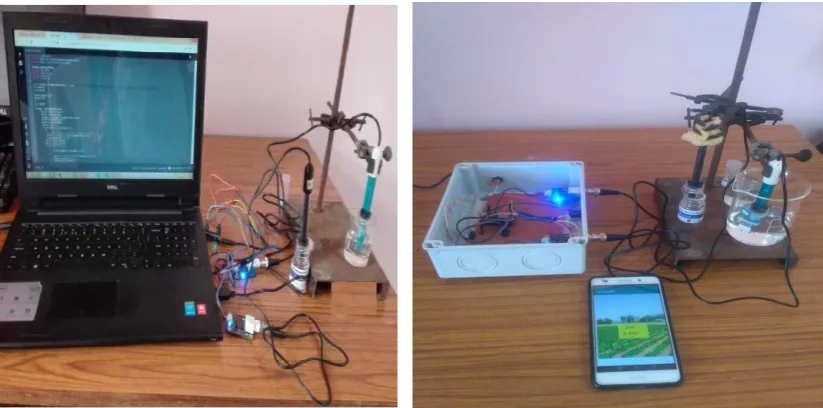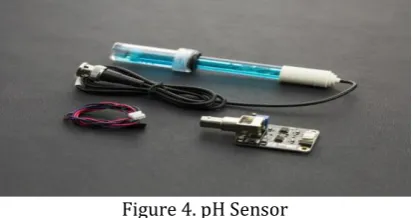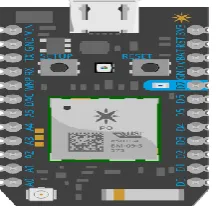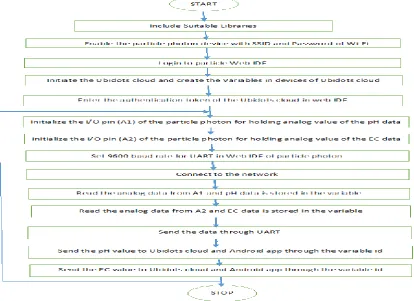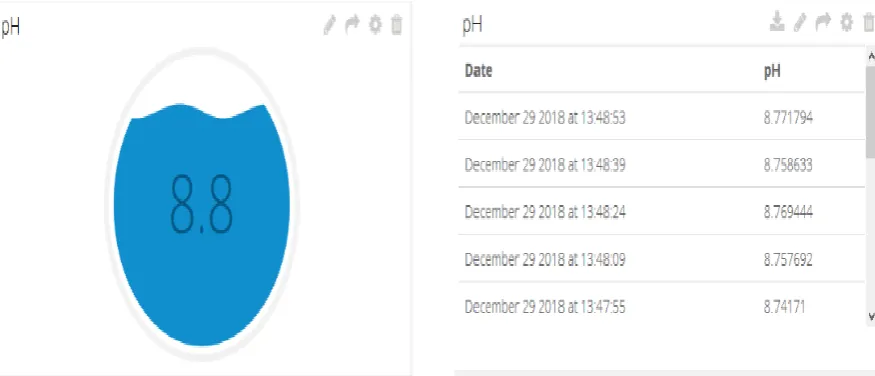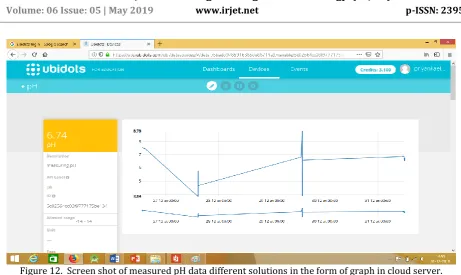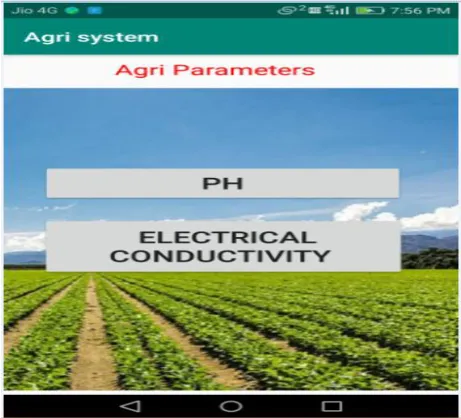Android Mobile based Spatial Evaluation of Physio Chemical
Parameters of the System
K. Priyanka Gandhi
1, B. Rama Murthy
2K. Tanveer Alam
3S. Sunita Ratnam
41
Research scholar, Department of Electronics, Sri Krishnadevaraya University, Anantapur, A.P,India.
2Professor, Department of Instrumentation, Sri Krishnadevaraya University, Anantapur, A.P, India.
3
Assistant Professor(C), Department of Electronics, Rayalaseema University, Kurnool, A.P, India.
4Associate Professor, Department of Physics, Malla Reddy Engineering College for Women, Hyderabad,
Telangana, India.
---***---
Abstract -
A Wireless Sensor Network (WSN) is widely used in precession agriculture applications. Sensors play a vital role in WSN. The measurement of physiochemical parameters such as soil pH and Electrical Conductivity is arguably the most widely performed test in the field of agriculture. They are used to predict of various chemical activities within the soil and the presence of salts in the soil. The present embedded system, is proposed to give information about physiochemical parameters and to send the same to the mobile application and cloud server through the microcontroller with Wi-Fi module. This system avoids the presence of the farmer in the field and plants can get optimum level of fertilizers. Hence it is helpful to increase the productivity of crops.Keywords: Particle Photon Microcontroller with Wi-Fi module, pH and Electrical Conductivity Sensors and Android Mobile.
I.
INTRODUCTION
Modern agriculture and civilization in agriculture together demand an increase in the production of food to feed the global population. New technologies and solutions [1] are being applied in agricultural domain to provide an optimal alternative to gather and process information [2]. Agriculture parameters measurement is a very useful tool in making management decisions concerning which type of plants are suitable for location, identification of nutrients in the soil suitable for different plants. Hence the possibility to modify soil pH and Electrical Conductivity either up or down through the fertilizers in particular crop becomes essential. In this farming, automation and intelligent decision making are also become more important to accomplish [3]. The agriculture domain is mostly explored area of concerning the application of IoT in improving the traditional methods of farming. IoT is a potential tool towards the target of self-organized, decision making, and automation in the agriculture farming. IoT includes Precision agriculture [4], automated irrigation scheduling, and optimization of plant growth, farm land monitoring and greenhouse monitoring and farming production process management in crops [5].
II. LITERATURE SURVEY ON EARLIER WORKS
In this section some relevant works connected to the parameters of agriculture with IoT and GSM technology are presented as the work describes about precision farming solution in Egypt using the wireless sensor network technology [6]. Sherine M. et. Al. Internet of things for smart agriculture technologies, practices and future direction [7]. Partha Pratim Ray et. Al. Soil pH and Electrical Conductivity: A County Extension Soil Laboratory Manual [8]. E. A. Hanlon et. Al. Temporal and Spatial evolution of enzymatic activities and physico – chemical properties in an agricultural soil [9]. M.A. Aon et. Al.
Low power pH sensor for – wireless sensor network node agricultural application [10]. Kshitij Shinghal et. Al. Present
status of precision farming [11]. Pinaki Mandal et. Al. Fabrication of a two-dimensional pH image sensor using a charge transfer technique [15]. Hizawa,T et, Al. Environmental wireless sensor networks [16]. P. Corke, et Al
III. Development of Hardware and Software of Android based Evolution of physio chemical parameters
The block diagram of the physio chemical parameters in agriculture system with IoT is shown in figure 1, the schematic diagram in figure 2 and Experimental arrangement in figures 3 and 4. The Agriculture System consists of mainly the following units.
1. pH Sensor
4. Ubidots Cloud Server 5. Android Mobile
[image:2.595.137.460.161.315.2]The description of each of these units and their interfacing with Particle Photon is presented below.
[image:2.595.97.509.540.744.2]Figure 1. Block diagram for Android Mobile based evaluation of Physiochemical parameters
Figure 2. Schematic diagram for Android based evaluation of physiochemical parameters
3.1. pH Sensor
[image:3.595.195.402.197.306.2]In the present study, the pH sensor is used for measuring the water quality in the soil [12]. It interfaces with the analog I/O pin of the microcontroller and this microcontroller reads the information from the sensor. The pH is the logarithmic measurement of hydrogen ions per liter of solution. It varies from 0 to 14 [13]. The solutions with pH value between 0 to 7 are acidic solutions with large concentration of hydrogen ions whereas, solutions with pH value between 8 to 14 are basic solutions with small hydrogen concentration. The solutions with pH value of 7 are neutral solutions.
Figure 4. pH Sensor
The potential difference between the two electrodes gives hydrogen ion concentration of the system [14] and the corresponding value in the form of voltage is given. The sensor has the following features
1. Operating voltage : 5.0V
2. The range of pH data : 0-14 pH
3. DC Current for 3.3V Pin:10 mA
4. Conversion time : 1 minute
5. Frequency :70MHz
6. Operating temperature: (0-60)°C
3.2. Electrical Conductivity Sensor
In the present work, Electrical Conductivity (EC) sensor as shown in Figure-3 is used for measuring the salinity of the soil. It interfaces with the microcontroller of the analog i/o channel and this microcontroller reads the data from the sensor. The EC test is of at most importance to determine the condition in field. When ions are present in soil, the EC of the solution increases. If no salts are present, then the EC is low indicating that the solution does not conduct electricity well. The EC indicates the presence or absence of salts, but does not indicate the salts that might be present.
Figure 5. Electrical Conductivity Sensor
If the water being used for irrigation contains appreciable salts, then intensive management is required to produce healthy plants. The Sensor has the fowling features.
1. Operating voltage : 5.0V
2. The range of electrical conductivity data : 0-20 ms/cm
3. DC Current for 3.3V Pin:10 mA
4. Conversion time : 1 minute
5. Frequency :70MHz
6. Operating Temperature: (0-60)°C
3.3. Particle Photon (Arm cortex with Wi-Fi Module)
[image:4.595.245.354.196.300.2]In the present work the particle photon (Microcontroller with Wi – Fi Module) is used for interfacing with the sensors such as pH and Electrical conductivity and reading the data from the sensors.Particle photon is an IoT hardware development board, it combines a powerful ARM cortex M3 microcontroller with a Broadcom Wi-Fi chip and a piece of software, or Web IDE (Integrated Development Environment) that runs on computer, used to write and upload computer code to the physical board which is shown in figure-4.
Figure 6. Particle Photon (BCM43362 Wi-Fi chip)
The Photon has more capabilities in a small chip device with analog and digital communication interfaces andSPI (Serial
Peripheral Interface), I2C (Inter Integrated Circuit), I2S (Inter IC Sound), CAN (Controller Area Network), USB (Universal
Serial Bus) cable.The board has the following important features
Microcontroller with Wi-Fi module
Arm Cortex M3 STM32F205
Broadcom BCM43362 Wi-Fi chip
802.11b/g/n Wi-Fi
On-board RGB (Red Green Blue) status LED
Operating Voltage: 3.3V & 5V
Flash Memory: 1MB
3.4. Ubidots Cloud
In the present work Ubidots cloud server is used for to obtain the data from the microcontroller through Wi-Fi and to store and send the data to the display devices. It is one of the technology of IoT for analytics and visualization of information. Ubidots API keys accessed protocols are Very Simple Control Protocol (VSCP), Hyper Text Transfer Protocol (HTTP), Message Queuing Telemetry Transport Protocol (MQTT), Transmission Control Protocol (TCP) and User Datagram Protocol (UDP). These protocols provide a simple and secure connection for transceving data to and from their cloud service in real-time. Ubidots time series performance optimized for IoT data stored in the form of pdf files. The applications of this cloud server are interactive, real-time data visualization.
Figure 7. Ubidots Cloud
3.5.
Android Mobile
[image:4.595.190.408.587.702.2]the libraries includes media, graphics, 3d, SQLite, web browser library etc. The applications written in java. Some of basic applications include a calendar, email client, SMS program, maps, making phone calls, accessing the web browser, accessing your contacts list and others.
IV. Algorithm and Flow chart for Android based evaluation of physiochemical parameters
Algorithm and Flow chart for Advanced Agriculture System as presented below
Initialize the Particle Photon and with Suitable Libraries
Enable the Particle Photon device with SSID and password of the Wi-Fi Network
To create the account in the particle Web IDE (Integrated Development Environment) with email id and login tothe Web IDE.
To create the account in the Ubidots Cloud with email id and login to the Ubidots cloud Server. To select theVariable of dashboard of the Ubidots cloud server.
To enter the API key and Variable ID of the Ubidots cloud in to particle Web IDE.
Initialize the pH and Electrical conductivity sensors.
To set the baud rate for UART (Universal Asynchronous Receiver and Transmitter) in the web IDE of Particle andconnect to the Wi-Fi network.
Read the pH data through the analog (A1) I/O line of the Particle Photon device and data is stored in the variable.
Read the electrical conductivity data through the analog (A2) I/O line of the Particle Photon device and data isstored in the variable.
The pH and EC data send to the serial monitor through the baud rate (9600) and this data send to the UbidotsCloud server and also send to the Agri System App through the Ubidots Cloud Server.
[image:5.595.100.515.440.741.2]The process of measurement of physio chemical parameters is presented in figure 8.
V.
RESULTS AND DISCUSSION
The proposed Smart Agriculture System for measurement of physio chemical parameters using IoT has been successfully developed and implemented in our laboratory.
[image:6.595.79.526.158.334.2]Figure 9. Display of screen shot for measured pH values with standard solution of pH 4 in cloud server
[image:6.595.75.522.364.539.2]Figure 10. Display of screen shot for measured pH values with standard solution of pH 7 in cloud server
[image:6.595.89.527.567.755.2]
Figure 12. Screen shot of measured pH data different solutions in the form of graph in cloud server.
Figure 13. Display of Screen shot of measured values with standard solution of EC (1.60ms/cm) data in cloud server
[image:7.595.73.526.561.729.2]
Figure 15. Screen shot of the measured EC data with different solutions in the form of graph in cloud server.
Figure 16. App Icon of the Agri System and Registration form of Agri System in Mobile.
[image:8.595.87.510.370.611.2]Figure 17. Menu software of pH and electrical conductivity buttons in Android mobile.
[image:9.595.181.412.100.309.2]
Figure 18. Screen shot of the pH data with standard solutions 4 pH, 9pH and 7pH in Android mobile.
V.
CONCLUSION
The developed system is tested and implemented in our laboratory as an Android based Embedded System for Monitoring
of physiochemical parameters in the Soil using IoT and we found that the system was working to our satisfaction. The
system has advanced features like portable, low cost and standalone system. The System can be installed in urban remote places as well, to reduce the contaminants in the soil. The plants can get optimum level of fertilizers, to increase productivity of the crops. The future work of this paper is planned to develop more sensors that can be added up for proper monitoring of the field and installation of communication systems to help the user for providing the real time condition of the field in the form of MMS facility.
VI. REFERENCES
[1] S. Misra, P.V. Krishna, V. Saritha, H. Agarwal, L. Shu and M.S. Obaidat, “Efficient medium access control for
cyberphysical systems with heterogeneous networks”, IEEE Syst. J.9(1) (2015), 22–30.
doi:10.1109/JSYST.2013.2253421.
[2] A. Behzadan, A. Anpalagan, I. Woungang, B. Ma and H.-C. Chao, An energy efficient utility-based distributed data
routing scheme for heterogeneous sensor networks, Wirel. Commun. Mobile Comput. (2014).
doi:10.1002/wcm.2474.
[3] J.K. Hart and K. Martinez, Environmental sensor networks:A revolution in the Earth system science?, Earth
Sci.Rev. 78(3–4) (2006), 177–191.
[4] S.E. Díaz, J.C. Pérez, A.C. Mateos, M.-C. Marinescu and B.B. Guerra, A novel methodology for the monitoring of the
agricultural production process based on wireless sensor networks, Comput. Electron. Agric. 76(2) (2011), 252–
265.doi:10.1016/j.compag.2011.02.004.
[5] X. Dong, M.C. Vuran and S. Irmak, Autonomous precision agriculture through integration of wireless underground
sennetworks with center pivot irrigation systems, Ad Hoc Netw. 11(7) (2013), 1975–1987.
doi:10.1016/j.adhoc.2012.06.012.
[6] Sherine M. Abd El-kader, Basma M. Mohammad El-Basioni “Precision farming solution in Egypt using the wireless
sensor network technology” Electronics Research Institute, Computers and Systems Dept., Cairo, Egypt,6 (2013).
[7] Partha Pratim Ray, “Internet of things for smart agriculture: Technologies, practices and future direction” Journal
of Ambient Intelligence and Smart Environments 9 (2017) 395–420 395 DOI 10.3233/AIS-170440
[8] E. A. Hanlon, “Soil pH and Electrical Conductivity: A County Extension Soil Laboratory Manual”, IFAS University
extension of florida
[9] M.A. Aon, A.C. colaneri “Temporal and Spatial evolution of enzymatic activities and physico – chemical properties
in an agricultural soil”, Institute technologic ode chascomis ( CONICET ), c.c.164, 7130 chasomis, Buenos Aires, Aegentina Received 7 July 2000; accepted 2 july 2001
[10] Kshitij Shinghal, Arti Noor, Neelam Srivastava, Raghuvir Singh, “ Low power pH sensor for – wireless sensor
network node agricultural application” International Journal of Advances in Engineering & Technology, July 2011.©IJAET ISSN: 2231-1963 ,197 Vol. 1, Issue 3, pp.197-203
[11] Pinaki Mandal and V.K.Tewari, “Present status of precision farming”, International Journal of Agricultural
Research 2 (1) : 1-10,2007,ISSN 1816 – 4897.
[12] De Rooij, N.F.; Bergveld, P. The influence of the pH on the electrolyte-SiO2-Si system studied by ion-sensitive FET
measurements and quasi-static C-V measurements. Thin Solid Films 1980, 71, 327–331.
[13] Bard, A.J.; Faulkner, L.R. Estimated Potential Ranges in Aqueous and Non aqueous Solutions. In Electrochemical
Methods, Fundamentals and Applications; John Wiley & Sons Inc.: New York, NY, USA, 1980.
[14] Lue, C.-E.; Lai, C.-S.; Wang, I.-S.; Yang, C.-M. Sensitivity of trapping effect on Si3N4 sensing membrane for ion
sensitive field effect transistor/reference field effect transistor pair application. Sens. Lett. 2010, 8, 725–729.
[15] Hizawa, T.; Sawada, K.; Takao, H.; Ishida, M. Fabrication of a two-dimensional pH image sensor using a charge
transfer technique. Sens. Actuators B 2006, 117, 509–515.
[16] P. Corke, T.Wark, R. Jurdak,W. Hu, P. Valencia and D. Moore, Environmental wireless sensor networks,Proc. IEEE
